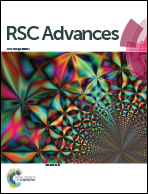New transparent poly(l-lactide acid) films as high-performance bio-based nanocomposites†
Abstract
A novel conceptual approach to introduce new features and improve the properties of poly(L-lactic acid) (PLLA) in the bulk state has been devised by introducing a specific compatibilizing agent within the bio-based polymeric building blocks. Here, a new polyhedral oligomeric silsesquioxane (POSS)-modified poly(DL-lactic acid) (TriPOSS–PLLA) has been developed, and exhibits a homogeneous amorphous phase and good thermal stability in the solid state owing to structural disorder induced by steric hindrance created by bulky tri-POSS. This newly-developed material behaves as an effective compatibilizer and exhibits dramatic improvements in film transparency, crystallization, mechanical performance and barrier properties compared to commercial PLLA. At the optimized blending ratio of 90 wt% PLLA and 10 wt% TriPOSS–PLLA, the composite film has a high optical transmission (over 90%), two-fold higher tensile strength (48.9 MPa) than pristine PLLA and a 33.4% lower oxygen permeation rate than pristine PLLA. Excitingly, hydrolytic degradation experiments indicated that TriPOSS–PLLA does not affect the overall degradation of PLLA. Thus TriPOSS–PLLA has superior mechanical performance and significantly reduced oxygen permeability; both of these properties are highly desirable for environmentally-friendly products in food packaging technologies and other applications.


 Please wait while we load your content...
Please wait while we load your content...